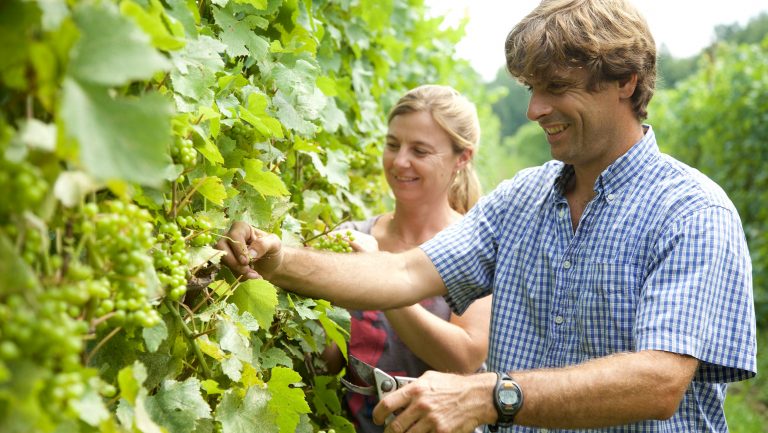When you think of Canada, chances are that wine doesn’t immediately leap to mind (at least not before Mounties, poutine, or politeness). But in the next 20 or 30 years, that may change as average global temperatures inch up. Many regions that we currently associate with world-class wines could become too warm to produce quality juice, leaving those on today’s cold-climate fringes with the potential to take center stage. A warming climate has already helped strengthen Canada’s major wine regions, from the Annapolis Valley on the east coast to the Okanagan Valley in the west.
The planet’s average temperature has risen 2 degrees Fahrenheit since the late 19th century, with 16 of the 17 warmest years on record having occurred since 2001, according to NASA and NOAA data. And the trend is only expected to continue. Antarctica is melting three times as fast as it was a decade ago, sea levels are rising, and oceans may soon be too warm to support coral reefs.
It’s unhappy news—unless you’re a Canadian winemaker. Winters have become milder and growing seasons longer, allowing Canada’s wine regions to thrive. “There was a time you couldn’t grow red vinifera varieties here. It was all cold-hardy hybrids until the ’90s,” says Phil McGahan, the winemaker at CheckMate Artisanal Winery in the Okanagan Valley, which focuses on Chardonnay and Merlot. “Now we’re confident we can get the length of season required for ripening.”

Don’t miss the latest drinks industry news and insights. Sign up for our award-winning newsletters and get insider intel, resources, and trends delivered to your inbox every week.
Originally from Australia, McGahan worked in California for several years, where he noted that the harvest was coming earlier and earlier each season. He grew concerned about rising temperatures, and in 2013 he made the move to British Columbia, where he believed warming could benefit winemaking: the climate was becoming increasingly well suited to Chardonnay. Half a century ago the Okanagan Valley would just barely have reached the temperature range within which Chardonnay can ripen. Today it’s well within that range.
Merlot, meanwhile, was just outside its ideal temperature range only 20 or 30 years ago in the valley; some years it would achieve its full ripening potential and others it wouldn’t. “Now we’re just inside that range where we ripen consistently,” says McGahan. “Being so close to that edge pushes the vines even further. It allows us to make wines that are quite distinct.”
The warming trend has had a range of benefits for Canadian winemaking. Grapes now have a better chance of achieving optimal ripeness, which has generally improved both the quality of the wines and their consistency. Growers are also experimenting with varieties that previously would have struggled to ripen—especially reds that need more time on the vine.
A wider variety of clones can also now be used by growers in the region. “Traditionally, people around here used the Dijon [Chardonnay] clone because it was designed for a cooler climate,” explains McGahan. “We’re introducing UC Davis clones from California, better suited to warmer weather, which will create more complexity in the wines.”
Yet climate change doesn’t express itself only in terms of warming, McGahan is quick to point out. It can also manifest as extreme weather events, including record snowfall, which causes flooding when the snow melts. In other words, climate change has brought opportunities to Canada’s wine regions, but also risk. Says McGahan, “We’re still on the edge.”
Wintering in the Vineyard
According to Tony Shaw, a climatologist at Brock University in St. Catharines, Ontario, Canada’s major wine regions are no longer seeing as much of the very low temperatures associated with vine damage. However, he notes, the country is seeing a lot more volatility. “Sometimes in January we get a thaw—a couple of weeks with relatively mild temperatures,” he says. “The buds begin to swell. Then, if you have a sudden drop in temperature, it can cause major damage.”
Despite milder temperatures across the country, extreme winters remain the number one challenge for Canadian winemakers. But “extreme” can vary from region to region, as certain parts of the country have always had harsher winters than others. In Quebec’s Montérégie, for example, where temperatures can hit the minus teens, measures are taken to protect the vines in winter. Growers bury them underground or pin them to the ground and then cover them with a layer of geotextile.
The next big obstacle is spring frost. Michael Marler of Les Pervenches in Eastern Townships, a small, biodynamic winery, says that while he experiences a drastic frost approximately every three years, he deals with some frost events annually. His primary defense is a wind machine. (Cold air descends and hot air rises, creating stratification; wind machines mix the air, warming what’s closest to the ground.) Quebec is not likely to warm so much that winter protection can be dispensed with anytime soon. Spring frost, on the other hand, could become a thing of the past.
“No one was talking about climate change back in 2000,” says Marler. That was when he and his wife, Véronique Hupin, started shopping around for a vineyard site. The couple had considered buying in South America, but after touring the Quebec wine route, they decided to stay close to home. Says Marler, “There was enough good stuff to see the potential.”
At the time, Marler had some inkling—or maybe merely hope—that the climate would warm. But only in the last 5 to 10 years has the reality of it become impossible to ignore. He recalls a trip his brother-in-law took to Mexico in late March 2012: it was warmer in Montérégie than in Cancún. Marler characterizes his first growing seasons as more balanced. Nowadays, he says, the weather “does all sorts of crazy things.” In just the last decade, the harvest has moved from October to September.
The World Wine Map of Tomorrow
Given the range of microclimates across Canada, the most important decision vintners can make is to choose the right varieties for their vineyard site. Encouraged by higher summer temperatures, some have tried to plant warm-climate varieties like Syrah and Pinot Grigio. Depending on the region, these grapes can do well in warmer months but often don’t survive the winter. Cold-climate varieties, like Riesling, however, are flourishing in many parts of the country. Growers in certain regions are even finding that Riesling does well in areas once considered marginal because of their very low temperatures. Every major wine region across the country is expanding this way—planting new sites, and varieties, that would have been considered too risky not long ago.
In fact, this is a global phenomenon. A 2013 study featured a world wine map that could look much different in 2050—the authors predicted that up to 73 percent of current vineyards would no longer be suitable to grow grapes by then. Wine country will have migrated to places like Northern Europe, Tanzania and—yes—Canada. Already the country has become too warm in many regions to support its original wine industry: ice wine.
Of course, most winemakers aren’t thinking about 2050. They’re too busy worrying about what this year’s vintage will look like. In Nova Scotia’s Annapolis Valley, the outlook for 2018 is uncertain after a never-before-seen frost hit the region—in June. “We’ve never had frost so cold, so late,” says Gina Haverstock, the winemaker at Gaspereau Vineyards. “Depending on the variety and where it was planted, some people won’t get any fruit this year.”

Vinifera, such as Riesling, is especially at risk. Hybrid varieties have a better chance of surviving frost. The white L’Acadie Blanc, bred in Niagara, and the high-acid, Alsace-bred reds Lucie Kuhlmann and Maréchal Foch are among the varieties that thrive in Nova Scotia. According to Haverstock, the key to growing grapes in a region like Nova Scotia—where winters are intense and increasingly unpredictable—is the ability to manage risk. “You don’t want a vineyard with 100 percent susceptible vines,” she says. While Gaspereau planted some of the first Riesling in the province, in the early 2000s, she mitigates the risk with several cold-hardy hybrids.
The phenomenon of climate change is a paradox for Canada, as Haverstock sees it. “Yes, temperatures are warming,” she says. “And that’s good for us. The problem is these unpredictable weather events—hurricanes, hail, heavy rains.” Canadian winemakers have gained confidence that they can compete effectively within the international wine industry. But climate change, which helped shape Canadian wine, is fickle. It can just as easily cause a winemaker to lose it all.

Dispatch
Sign up for our award-winning newsletter
Don’t miss the latest drinks industry news and insights—delivered to your inbox every week.
A Montreal native now based in New York, Chantal Martineau writes about wine, spirits, food, travel, and culture. Her writing (sometimes accompanied by her own photography) has been published in Vogue, Food & Wine, Departures, Saveur, and The Atlantic. She is the author, with Ron Cooper, of Finding Mezcal: A Journey Into the Liquid Soul of Mexico and the author of How the Gringos Stole Tequila.







